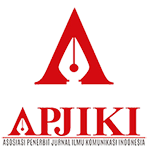The Influence of Electronic Word of Mouth on Somethinc Brand Image Among Millienial and Gen Z
Abstract
The large number of people using Twitter to obtain information has resulted in several Twitter accounts using the autobase feature, such as the @ohmybautybank account. On the @ohmybautybank account, there are many discussions about cosmetic and skincare products. This study aims to measure how much influence Electronic Word of Mouth has on Brand Image Somewhat among Millennials and Gen Z (Study of Followers of the Ohmybautybank Twitter Account). The research method used was quantitative descriptive, using a probability sampling technique to 400 respondents was carried out by distributing questionnaires online to followers of the Twitter account @ohmybeautybank. Based on the results of the analysis of the Electronic Word of Mouth regression model on social media Twitter has a significant influence on Brand Image Something. Then the influence of Electronic Word of Mouth on Brand Image Something is 42.2% while the rest is influenced by other factors outside this study.
Keywords
Full Text:
PDF (ENGLISH)References
Adriyati, R., & Indriani, F. (2017). The Influence of Electronic Word of Mouth on Brand Image and Purchase Interest in Wardah Cosmetic Products. Diponegoro Journal of Management, 6, 1–14. http://ejournal-s1.undip.ac.id/index.php/dbr
Bentri, SA, Noviadji, BR, Ayu, N., & Karuna, M. (2022). DESIGNING AN ILLUSTRATION ABOUT TOXIC RELATIONSHIP FOR COUPLES BEFORE MARRIAGE VIA INSTAGRAM MICROBLOG. 6 (2), 138–152.
Chaffey, D., & Chadwick, F. (2016). Digital Marketing: Strategy, Implementation and Practice, 6/E (sixth edition). Pearson Education.
Charo, N., Sharma, P., Shaikh, S., Haseeb, A., & Sufya, M. Z. (2015). Determining the impact of eWOM on brand image and purchase intention through adoption of online opinions. International Journal of Humanities and Management Sciences, 3 (1), 41–46. http://www.isaet.org/images/extraimages/P115054.pdf
Cheung, C. M. K., & Thadani, D. R. (2012). The impact of electronic word-of-mouth communication: A literature analysis and integrative model. Decision Support Systems, 54 (1), 461–470. https://doi.org/10.1016/j.dss.2012.06.008
Creswell, J. W., & David, J. (2018). Research Design Qualitative, Quantitative, and Mixed Methods Approaches. SAGE Publications.
Darmawan, D. (2013). Quantitative Research Methods. PT. Rosdakarya Teenager.
De Bruyn, A., & Lilien, G.L. (2008). A multi-stage model of word-of-mouth influence through viral marketing. International Journal of Research in Marketing, 25 (3), 151–163. https://doi.org/10.1016/j.ijresmar.2008.03.004
Diamond, S. (2020). Social Media Marketing For Dummies, 4/E.
Field, A. (2013). Discovering Statistics Using IBM SPSS Statistics . SAGE Publications.
Goyette, I., Richard, L., Bergeron, J., & Marticotte, F. (2010). E-WOM Scale: Word-of-mouth Measurement Scale for e-service context. https://doi.org/http://dx.doi.org/10.1002/cjas.129
Hariono, L. (2019). Can E-Wom (Electronic Word of Mouth) Beat Wom (Word of Mouth) in influencing sales of culinary products. Competence: Journal of Management Studies, 12 (1). https://doi.org/10.21107/kompetensi.v12i1.4946
Hikmawati, F. (2017). Research methodology. Rajawali Press.
Hossain, I. (2018). Measuring Influence of Green Promotion on Green Purchase Behavior of Consumers: A Study on Bangladesh Measuring Influence of Green Promotion on Green Purchase Behavior of Consumers: A Study on Bangladesh Md. Imran Hossain.
Indrawati. (2015). Management and Business Research Methods, Convergence of Communication and Information Technology. Refika Aditama.
Jalilvand, M.R., & Samiei, N. (2012). The effect of electronic word of mouth on brand image and purchase intention: An empirical study in the automobile industry in Iran. Marketing Intelligence and Planning, 30 (4), 460–476. https://doi.org/10.1108/02634501211231946
Jecky, J., & Erdiansyah, R. (2021). The Influence of Social Media Advertising and Word of Mouth on Purchasing Decisions. Prologia, 5 (2), 307. https://doi.org/10.24912/pr.v5i2.10199
Lestari, G., & Ali, DSF (2020). Purwakarta Regency Dsporaparbud Marketing Communication Strategy Through the Sampurasun Application Media in Promoting Tourism. LINIMASA Journal, 3 (1), 13–18. https://journal.unpas.ac.id/index.php/linimasa/article/view/2056/1089
Neolaka, A. (2014). Research Methods and Statistics . PT. Rosdakarya Teenager.
Rizqiyah, N., & Dewi, DA (2021). The Influence of Twitter Social Media on the National Insight of Indonesian Teenagers from a Social Psychology Perspective. Journal on Education, 3 (3), 230–235. https://doi.org/10.31004/joe.v3i3.372
Rosana, J. (2021). The Influence of Electronic Word Of Mouth (Ewom) Autobase Twitter Ombb (Ohmybeautybank) Followers on Purchase Decisions for Love Beauty and Planet Products. 2012. https://repository.unja.ac.id/24705/
Sari, VM (2012). The Influence of Electronic Word of Mouth (eWOM) on Twitter Social Media on Consumer Purchase Interest (Study at Holycowsteak Restaurant). In FISIP Journal, University of Indonesia (Vol. 1, Issue 1).
Sekaran, U., & Bougie, R. (2017). Research Methods For Business. John Wiley & Sons.
SILABAN, RO (2017). The Influence of Ewom from the Beauty Vlogger Channel on Nature Republic's Brand Image Through the Aloe Vera 92% Soothing Gel Product (Case Study of Female Daily Indonesia Forum Members).
Socialbearing.com. (nd). No. Ti. https://socialbearing.com/
Sugiyono. (2018). Quantitative Qualitative Research Methods and R&D . ALPHABET.
Suryadi, E., Darmawan, D., & Mulyadi, A. (2019). Communication Research Methods with a Quantitative Approach . PT. Rosdakarya Teenager.
Suryani, T. (2013). Consumer Behavior in the Internet Era: Implications for Marketing Strategy.
Zhang, B. J. J. and M. (2013). Twitter Power: Tweets as Electronic Word of Mouth. Journal of the American Society for Information Science and Technology , 64 (July), 1852–1863. https://doi.org/10.1002/asi
DOI: https://doi.org/10.32509/wacana.v22i2.3114
Refbacks
- There are currently no refbacks.

This work is licensed under a Creative Commons Attribution-NonCommercial-ShareAlike 4.0 International License.
Indexed by:
Recommended Tools :
Wacana: Jurnal Ilmiah Ilmu Komunikasi
Fakultas Ilmu Komunikasi, Universitas Prof. Dr. Moestopo (Beragama)
Kampus I, Jl. Hang Lekir I/8 Jakarta Pusat, Indonesia 10270
WA: 085714422271 (Chat Only)
email: wacana@dsn.moestopo.ac.id
Copyright (c) 2025 Wacana: Jurnal Ilmiah Ilmu Komunikasi
Licensed under a Creative Commons Attribution-ShareAlike 4.0 International License.














